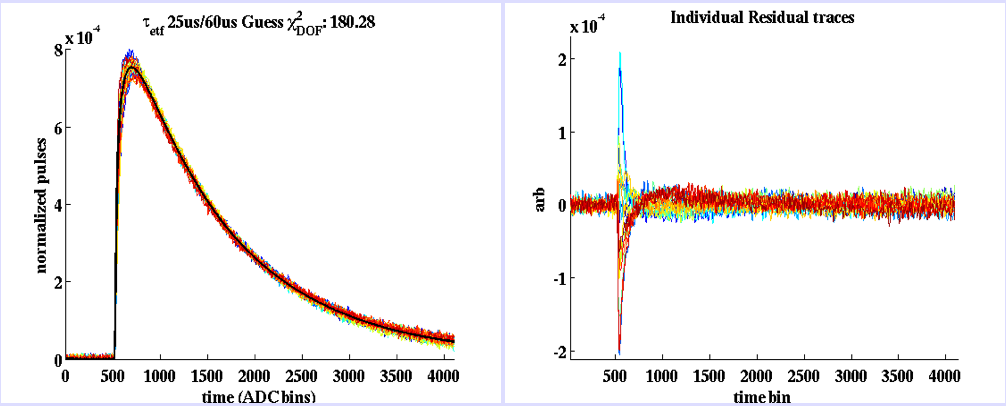Non-stationary Optimal Filter (NSOF)¶
Motivation¶
So far all OF methods deal with stationary noise (See the first link in Refs). As the name suggests this is a more general OF algorithm which works with non-stationary (NS) noise i.e. noise with non-trivial time-time correlations.
iZIP phonon pulses are very homogeneous, but the pulse shapes have some position dependence. The goal is to make an OF filter where we can account for the variation of the pulse shapes due to this position dependence. Ideally we can design templates with the exact mechanism of how location affects the shape. But this OF treats the postion dependence as non-stationary noise, and works out the best fit template.
As shown by Matt Pyle (see second item in Refs), if we consider a bunch of traces (traces here → total phonon or pt pulses. pt-pulses are generated by summing pA..pD pulses post relative calibrations.) with the same arrival time t_{0} (See left fig.), there is still some difference in the pulse shapes around t_{0}. This is because of position dependence. So subtracting an averaged template (black curve in left plot), leaves us with some non-trivial residual (right fig.). Ideally if one understands all the detector nuances, we can model this into our template and the subtraction will not have a residual that is time dependent.

But for now let's assume we can't do this modeling exactly. So the residual looks like non-stationary noise. Again it's not really noise, but we can model the residual as non-stationary noise viz. S(t)-aA(t) → noise(t).
We can hence encode our ignorance of such position dependence in noise(t-t_{0}), and thus design a NSOF. With this modified noise we can pursue a fitting technique.
Theory¶
In designing a template-to-signal fitting discriminant called \chi^{2}, the Power Spectral Density J(\nu), of the noise enters as the per-bin weight (the weight is exactly 1/J(\nu) . Each bin corresponds to a frequency (\nu) and we sum over all frequencies.
In the regular OF, the low frequency components are under weighted i.e. the algorithm stresses on the time region which sees the onset of the pulse.
In our case the iZIP pulses are homogeneous apart from the position dependent fluctuations which are predominant only in the first ~ 100\mu s. By subtracting an average template, we are essentially modeling these as spikey noise (the residual) at the pulse onset time. So we'd like to deweight this portion instead. This is precisely what the NSOF does.
Now because of the time-time correlation in the noise, we have non-trivial frequency-frequency correlations. And thus for the NSOF, we elevate the PSD to the autocovariance matrix. The derivation of this is in sec. 5 of the attached pdf note.
J(\nu)=\langle|\tilde{n}(\nu)|^{2}\rangle \mapsto \tilde{V}(\nu,\nu ')=\langle\tilde{n}^{\ast}(\nu '-\nu)\tilde{n}(\nu)\rangle
Since V is constructed out of these spikey noise traces, it is bigger for frequencies corresponding to the small time window around t_{0}. So in the \chi^{2} such bins are comparatively underweighted. By construction, this matrix V is non-commutative and one has to deal with the mathematics carefully. We pursue a 1-D NSOF starting with our usual S(t)=aA(t)+n(t). We then get an estimate for the best a. Because of the added noise complications, this 1-D method is not as simple as its stationary counterpart. In the end the best amplitude is a function of t_{0}:
\hat{a}(t_{0})=\frac{\sum_{\nu\nu '}\tilde{S}^{\ast}(\nu)e^{i2\pi t_{0}}\{\tilde{V}(\nu,\nu ')^{-1}\}\tilde{A}(\nu ')}{\sum_{\nu\nu '}\tilde{A}^{\ast}(\nu)\{\tilde{V}(\nu,\nu ')^{-1}\}\tilde{A}(\nu ')}
and thus we write the \chi^{2} (t_{0}),
\chi^{2}(t_{0})=\sum_{\nu\nu '}\tilde{S}^{\ast}(\nu)e^{i2\pi t_{0}}\{\tilde{V}(\nu,\nu ')^{-1}\}\tilde{S}(\nu ')e^{-i2\pi t_{0}}-\hat{a}^{2}(t_{0})\tilde{A}^{\ast}(\nu)\{\tilde{V}(\nu,\nu ')^{-1}\}\tilde{A}(\nu ')
The best t_{0} is found by looking for the min {\chi^{2} (t_{0})} around some expected value of best t_{0}. See sec. 5 of the attached note in the third reference for the full derivation.